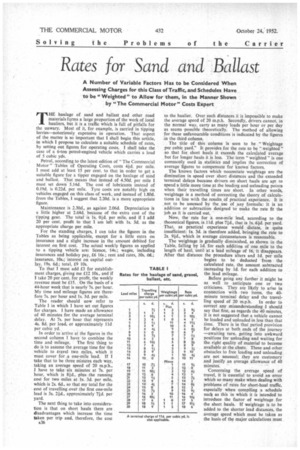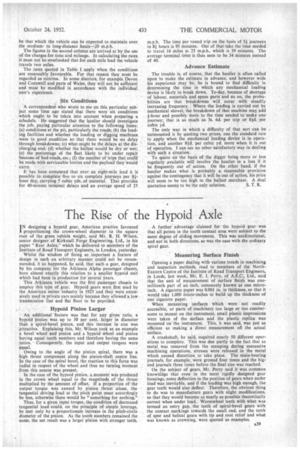Rates for Sand and Ballast
Page 54

Page 57

If you've noticed an error in this article please click here to report it so we can fix it.
A Number of Variable Factors Has to be Considered When Assessing Charges for this Class of Traffic, and Schedules Have to be "Weighted" to Allow for them, in the Manner Shown by "The Commercial Motor" Costs Expert
THE haulage of sand and ballast and other road materials forms a large proportion of the work of local hauliers, but it is a traffic which is full of pitfalls for the unwary. Most of it, for example, is carried in tipping lorries--notoriously expensive in operation. That aspect of the matter is so important that I shall begin this article, in which I propose to calculate a suitable schedule of rates, by setting out figures for operating costs. I shall take the case of a 6-ton petrol-engined vehicle which carries a load of 5 cubic yds.
Petrol, according to the latest edition of "The Commercial Motor" Tables of Operating Costs, costs 40. per mile. I must add at least 15 per cent, to that in order to get a suitable figure for a tipper engaged on the haulage of sand and ballast. That means that instead of 4.50d. per mile I must set down 5.14d. The cost of lubricants instead of 0.19d. is 0.22d. per mile. Tyre costs are notably high on vehicles engaged on this class of work, and instead of 1.80d. from the Tables, I suggest that 2.20d. is a more appropriate figure.
Maintenance is 2.30d., as against 2.06d. Depreciation is a little higher at 2.64d. because of the extra cost of the tipping gear. The total is Is. 00. per mile, and if I add 20 per cent, profit to that I am left with is. 3d. as the appropriate charge per mile.
For the standing charges, I can take the figures in the Tables as being applicable, except for a little extra on insurance and a slight increase in the amount debited for interest on first cost. The actual weekly figures as applied to a tipping vehicle are: licence, 14s.; wages, including insurances and holiday pay, £6 16s.; rent and rates, 10s. 611.; insurance, 10s.,; interest on capital outlay, 19s. 6d.; total, £9 10s.
To that I must add £3 for establishment charges, giving me 1.12 10s., and if I take 20 per cent. for profit, the weekly revenue must be £15. On the basis of a 44-hour week that is nearly 7s. per hour. My time and mileage figures are therefore 7s. per hour and Is. 3d. per mile.
The reader should now refer to Table I in which I have set out figures for charges. I have made an allowance of 40 minutes for the average terminal delay. At 7s. per hour that represents 4s. 8d. per load, or approximately lld per cubic yd..
In order to arrive at the figures in the second column I have to combine the
time and mileage. The first thing to do is to assume the average time for the vehicle to ,travel two miles, which it must cover for -a one-mile lead. If I take that to be three minutes each way, taking an average speed of 20 m.p.h., I have to take six minutes at 7s. per hour, which is 80., phis the running cost for two miles at Is. 3d. per mile, which is 2s. 6d., so that my total for the cost of travelling over the first one-mile lead is 3s. 20., approximately 71d. per yard.
The next thing to take into consideration is that on short hauls there are disadvantages which increase the time taken per trip and, therefore, the cost a36
to the haulier. Over such distances it is impossible to make the average speed of 20 m.p.h. Secondly, drivers cannot, in the normal way, carry as many loads per hour or per day as seems possible theoretically. The method of allowing for these unfavourable conditions is indicated by the figures
• in the third column.
The title of this column is seen to be " Weightage per cubic yard." It provides for the rate to be " weighted" so that for short hauls it exceeds the calculated average but for longer hauls it is less. The term " weighted " is one commonly used in statistics and implies the correction of average figures to compensate for known factors.
The known factors which necessitate weightage are the diminution in speed over short distances and the extended terminal delays because drivers on short hauls are apt to spend a little more time at the loading and unloading points when their travelling times are short. In other words, weightage is a method of correcting the theory of calculations in line with the results. of practical experience. It is not to he assessed by the use of any formula: it is an addition or subtraction designed to make the rate fit the job as it is carried out.
Now, the rate for a one-mile lead, according to the theoretical figures, is 11d. plus 70., that is Is. 60. per yard. That, as practical experience would dictate, is quite insufficient: Is. 3d. is therefore added, bringing the rate to 2s. 90., which in average circumstances is reasonable.
The weightage is gradually diminished, as shown in the Table, falling by Id. for each addition of one mile to the length of haul, until at a lead mileage of 16, it disappears. After that distance the procedure alters and Id. per mile begins to be deducted from the calculated rate, the amount subtracted increasing by Id. for eadh addition to the lead mileage. LE 1 Before going any further it might be as well to anticipate one or two criticisms. They are likely to arise in connection with two items, the 40minute terminal delay and the travel ling speed of 20 m.p.h. In order to correct any misunderstanding I should say that first, as regards the 40 minutes, ills not suggested that a vehicle cannot be loaded and unloaded in less than that time. There is in that period provision for delays at both ends of the journey —awaiting turn, getting into awkward positions for unloading and waiting for the right quality of material to become available at the chute. These and other obstacles to free loading and unloading are not unusual; they are customary and justify an average allowance of 40 minutes.
Concerning the average speed of travel, it is essential to avoid an error which so many make when dealing with problems of rates for short-haul traffic, especially when compiling a schedule such as this in which it is intended to introduce the factor of weightage for the short hauls. If weightage is to be added to the shorter lead distances, the average speed which must be taken as the basis of the major calculations must
be that which the vehicle can be expected to maintain over the mediumto long-distance hauls-20 m.p.h.
The figures in the second column are arrived at by the use of the charges for time and mileage. In calculating the rates it must not be overlooked that for each mile lead the vehicle travels two miles.
The rates quoted in Table I apply when the conditions are reasonably favourable. For that reason they must be regarded as minima. In some districts, for example Devon and Cornwall and parts of Wales, they will not be sufficient and must be modified in accordance with the individual user's experience.
Six Conditions
A correspondent who wrote to me on this particular subject some time ago stated that there were six conditions which ought to be taken into account when preparing a schedule. He suggested that the haulier should investigate the job, paying particular attention to the following items: (a) conditions-at the pit, particularly the roads; (b) the loading facilities and whether the loading or digging machines were in good condition so that there would be no delay through breakdowns; (c) what might be the delays at the discharging end; (d) whether the ballast would be dry or wet; (e) the percentage of the fleet likely to be under repair because of bad roads, etc.; (f) the number of trips that could be made with serviceable lorries and the payload they would carry.
It has been computed that over an eight-mile lead it is possible to complete five to six complete journeys per 84hour day, carrying 5 cubic yds. of material. That provides for 40-minute terminal delays and an average speed of 25 m.p.h. The time per round trip on the basis of 51 journeys in 81 hours is 93 minutes. Out of that take the time needed to travel 16 miles at 25 m.p.h., which is 39 minutes. The average terminal time is thus seen to be 54 minutes instead of 40.
Advance Estimate The trouble is, of course, that the haulier is often called upon to make the estimate in advance, and however wide his experience may be, he is bound to find difficulty in determining the time in which any mechanical loading device is likely to break down. To-day, because of shortage of labour, materials and spare parts and so on, the probabilities are that breakdowns will occur with steadily increasing frequency. Where the loading is carried out by mechanical shovel, the breakdown of that machine may. add fhour and possibly more to the time needed to make one journey; that is as much as 3s. 6d. per trip or 81d. per cubic yd.
The only way in which a difficulty of that sort can be surmounted is by quoting two prices, one the standard rate to apply when the mechanical loading device is in operation, and another 84d. per cubic yd. more when it is out of operation. I can see no other satisfactory way in dealing with such a situation.
To quote on the basis of the digger being more or less regularly available will involve the haulier in a loss if it be frequently out of action. On the other hand. if the haulier makes what is probably a reasonable provision against the contingency that it will be out of action, his price will seem to be too high to the ballast merchant. A dual quotation seems to be the only solution. S. T. R.




















































































